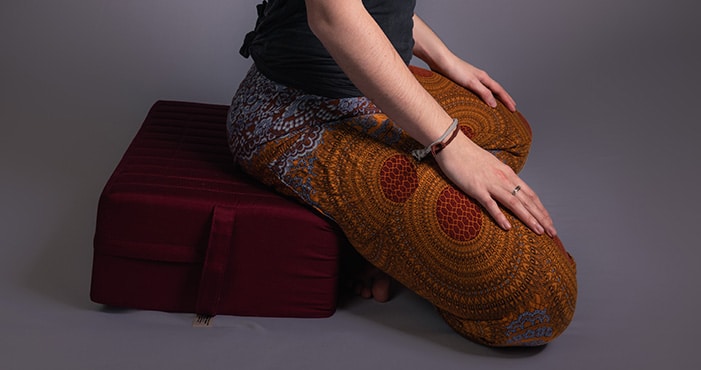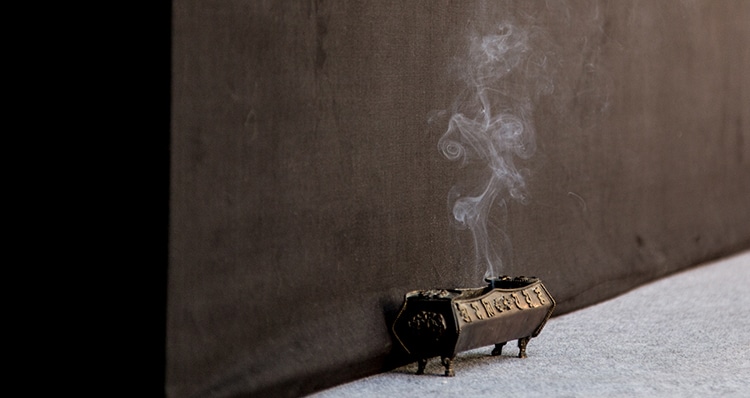Do You Need a Cushion to Meditate?
Category: Beginners Guide to Meditation

The short answer is… maybe.
You could try meditating on a chair for starters, or simply sit on the floor if you want. Use pillows or cushions from your furnishings for a trial run. Eventually, though, if you’re not sitting upright on a chair, you’ll probably do well to buy a dedicated meditation cushion. The cushion will support your sitting posture and help you create an appealing mindfulness corner that will encourage you to practice every day. And there’s no Rolls Royce of cushions – they’re generally pretty affordable. The thing is to find just the right one.
The fine art of sitting
There are many types of ancient meditation cushions. In the past, Chinese nuns and monks had hand-woven mats made of dried grass. They carried these mats on their backs and would use them as protection if it rained. If there was dew on the ground, the nuns and monks would place their mats on the ground and settle in on them. They could sit for hours with their legs crossed and their eyes half-closed in deep meditation. Although these grass cushions were common back in the day, they’re not easy to find today. Imagine if such a mat were the only meditation pillow available to you – sitting for long periods would probably be a real challenge!
In modern-day Asia – in India and Nepal for instance – people often sit on the ground on mats to do their everyday chores, as they have for centuries. In rural areas, school children might use a cow shed as a classroom during daylight hours, sitting on the straw while the cow is out grazing. In upscale homes as well, meals are often taken while seated on a carpet and cushions around a low table.
People who have been sitting on the floor cross-legged since their childhood often have an easier time adapting to classic meditation postures such as the lotus position than those who are used to tables and chairs, like most westerners are. If you practice yoga, dance, stretching or other physical activities that promote flexibility, you’ll likely find it pretty easy to adapt to sitting on a cushion.
Cushion, chair, bench, floor – it’s all good. As you practice, your body will get used to sitting in meditation and practice will become more and more comfortable. But if you have any signs of persistent pain or discomfort, see your doctor and make sure you’re not overdoing it.
How to pick a good meditation cushion
- Consider your meditation posture
Do you see yourself meditating on a cushion with your legs crossed (classic posture) or sitting on a bench or firm round cushion as if kneeling (Seiza style)? Especially if you are new to meditating, take some time to check out the options and choose whichever is most comfortable and sustainable meditation posture.
Here are the attributes of a good posture:
- Your back should be straight. This helps the body remain alert and focused.
- You need stability. This allows you to meditate without distractions.
- Comfort is important. Make sure you’re comfortable and relaxed during your meditation. If you’re ill at ease, your legs are falling asleep, or there’s too much tension, simply shift your posture or take a break and come back to your meditation when ready.
There are thin cushions, v-shaped cushions and zafus. The zafu meditation cushion is a round, relatively firm cushion that originates from Japan. Customarily used for Zazen (Japanese Zen meditation), it is sewn from heavy cloth and filled with a fluffy material such as kapok. Many Japanese meditation stories feature zafus, such as the one about a Zen master who went through 8 zafu cushions during his years of practice; he wore them out consecutively and each one ended up virtually flat as a pancake.
- Factor in your comfort
A comfortable meditation pillow will motivate you to meditate consistently. If you prefer the Seiza style of sitting, where you sit supported by a pillow or a bench in the kneeling posture, there are little wood benches and zafu meditation cushions that are designed for this. Seiza, which originated in Japan, is a good choice for meditators who prefer not to sit with their legs crossed. It encourages a straight back but doesn’t put undue stress on the knees and may be right for individuals who are older or less flexible.
For more information, check out these additional articles: Different Types of Meditation Poses and Postures and Top 5 Buddhist Meditation Postures.
- Materials used to make cushions
The main materials used to make meditation cushions are:
- Kapok fiber, a natural cottony material that comes from tropical trees
- Wool
- Cotton
- Polyester
- Buckwheat hulls
Kapok fiber goes into firm cushions that hold your body steadily. If of inferior quality, clumping can be a problem. Buckwheat hulls make for a heavier meditation pillow and are a very popular choice for home meditation corners. They can be contoured to adapt to your sitting posture but won’t hold their shape from one session to the next. Wool cushions and meditation pillows are durable, lightweight and extremely comfortable. They’re not usually as firm as kapok-filled cushions and may be too spongy for those who like a solid, thick seat. Wool cushions support blood circulation and are often recommended by experts. You can also find zafu shells that are simply filled with an inflatable beach ball: perfect for travelers. Some meditators swear by poly-fill zafus; others prefer cotton. Savvy shoppers can usually find an acceptable version of either for around $20.
So now that you’ve got your cushion, it’s high time to use it.






